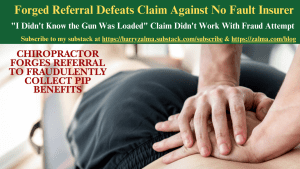Forged Referral Defeats Claim Against No Fault Insurer

Post 4915
See the full video at https://rumble.com/v5j6719-forged-referral-defeats-claim-against-no-fault-insurer.html and at https://youtu.be/PUoFigF-SG8
In a first-party personal injury protection (PIP) benefits claim plaintiff appealed the trial court’s order granting summary disposition in favor of defendant because it found no genuine issue as to any material fact.In Lint Chiropractic PC v. Allstate Indemnity Company, No. 367770, Court of Appeals of Michigan (October 8, 2024) the Court of Appeals resolved the dispute.
BACKGROUND
Plaintiff sough PIP benefits arising out of a car accident involving plaintiff’s uninsured patient, Taniqua Smith. With a referral to plaintiff by Dr. Pedro Toweh, M.D., Smith sought treatment with plaintiff for thoracic and lumbar spine pain allegedly resulting from the accident. Plaintiff provided Trigger Points Impedance Imaging (TPII) for Smith. Smith assigned her PIP benefits to plaintiff for the treatments that occurred from March 24, 2021, to July 1, 2021.
Smith was uninsured so plaintiff filed a claim under the Michigan Assigned Claims Plan (MACP). The Michigan Automobile Insurance Placement Facility (MAIPF) assigned defendant to plaintiff’s claim. Defendant refused payments to plaintiff. Plaintiff sued defendant to recover costs incurred for Smith’s treatment.
Defendant moved for summary disposition after initial disclosures revealed that the referral from Dr. Toweh that Smith used was forged. Defendant claimed plaintiff’s claim was not compensable because plaintiff committed a fraudulent insurance act.
Plaintiff claimed it had no knowledge that the referral was forged.
SUMMARY DISPOSITION
Plaintiff argued the trial court erred because defendant did not establish all of the necessary elements of a fraudulent insurance act to preclude plaintiff’s PIP claim. A person who presents or causes to be presented a claim for payment knowing that the statement contains false information commits a fraudulent insurance act that is subject to the penalties imposed by statute.
A person commits a fraudulent insurance act under the statute when:
the person presents or causes to be presented an oral or written statement,
the statement is part of or in support of a claim for no-fault benefits, and
the claim for benefits was submitted to the MAIPF.
the person must have known that the statement contained false information, and
the statement concerned a fact or thing material to the claim.
A claimant or a person making a claim through or on behalf of a claimant shall cooperate with the Michigan automobile insurance placement facility in its determination of eligibility and the settlement or defense of any claim or suit, including, but not limited to, submitting to an examination under oath.
Plaintiff maintained it did not know the referral was forged.
However, Plaintiff became aware of the forged referral when defendant filed its initial motion for summary disposition in district court, and defendant provided the affidavit of Dr. Toweh averring the referral was forged. Yet, Plaintiff provided no evidence that it was unaware of the forgery before litigation, such as by affidavit.
Defendant provided the affidavit of Dr. Toweh and the deposition of Smith to show, by deduction, the only interested party who could have made the forgery was plaintiff. Plaintiff simply asserted it lacked knowledge of the forgery.
No fault insurance schemes were created to provide benefits to all injured in an auto accident only for the states, like Michigan, who created no fault insurance have found that it is a magnet for fraud perpetrators. This is an example of a fraudulent claim made by a chiropractor that the court concluded used forgery to defraud an insurer assigned by the no fault plan. The plaintiff chiropractor was found to have forged the documents by claiming it had no knowledge of the fraud. In this case the good guys won but needed to take the case to a summary disposition motion and appeal.
 (c) 2024 Barry Zalma & ClaimSchool, Inc.
(c) 2024 Barry Zalma & ClaimSchool, Inc.
Please tell your friends and colleagues about this blog and the videos and let them subscribe to the blog and the videos.
Subscribe to my substack at https://barryzalma.substack.com/subscribe
Go to X @bzalma; Go to Newsbreak.com https://www.newsbreak.com/@c/1653419?s=01; Go to Barry Zalma videos at Rumble.com at https://rumble.com/account/content?type=all; Go to Barry Zalma on YouTube- https://www.youtube.com/channel/UCysiZklEtxZsSF9DfC0Expg
Go to the Insurance Claims Library – https://lnkd.in/gwEYk
Like this:
Loading…
Related
About Barry Zalma
An insurance coverage and claims handling author, consultant and expert witness with more than 48 years of practical and court room experience.



